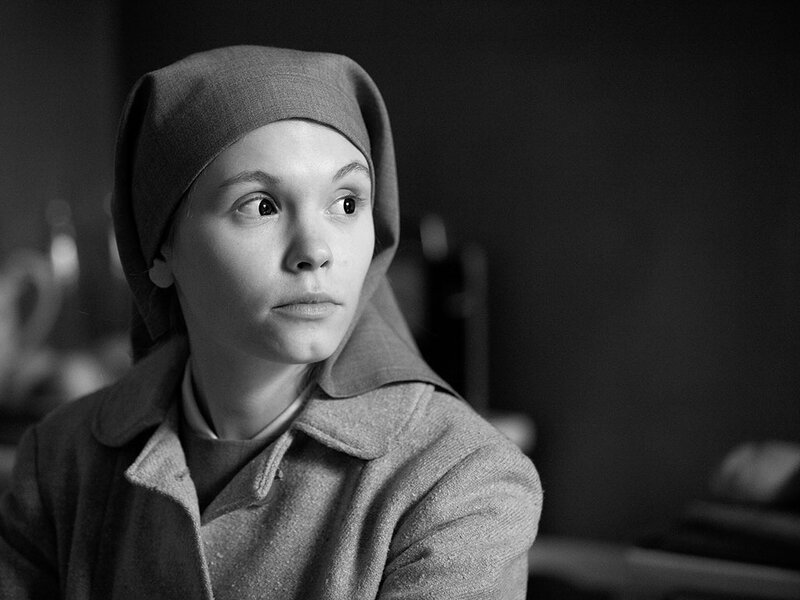'Ida' is a compelling search for answers in postwar Poland
Loading...
Set in the early 1960s, “Ida,” the compelling new film from Polish director Pawel Pawlikowski, is a small-scale movie about large-scale matters. One week before taking her vows in the convent where in 1945 she had been left on the doorstep as a baby, Anna (Agata Trzebuchowska) is encouraged by the Mother Superior to visit, before she makes her final decision, with the woman who has been identified as as the girl’s sole surviving relative. Wanda (Agata Kulesza), Anna’s mother’s sister, is a freewheeling magistrate and former Communist Party luminary whose boozy ways have reduced her to settling local disputes. She brusquely accepts the girl, who knew nothing of Wanda or her family’s existence, into her home and almost immediately drops the bombshell: Anna’s first name is really Ida, and she is Jewish.
At this point, the story could have evolved in any number of interesting ways. Ida could, for example, have renounced her vows and discovered Judaism, or renounced religion altogether. But, as we quickly discover, “Ida” is not so much a movie about religious faith as it is about the spiritual agonies of postwar Poland. It’s about the compulsion to resolve, no matter how unachievable, the horrors of the past.
Wanda and Ida – no two women could be further apart in temperament – set out across the bleak landscape to solve a mystery. Was it the Nazis, or neighbors, who killed their family? Wanda had left her sister and relatives behind during the war to fight as a partisan. She believed her family, hidden away, would be protected. It’s implicit here that Wanda, in reaching out to Ida, is trying to make amends – to protect her niece in a way she could not protect her family. But this protection comes at great cost. Ida, who never knew her family, must now confront the horrifying reality of their deaths.
She pursues this confrontation with a kind of fated resolve. With her wimple and her fine-boned features and big, wide eyes, Ida at first seems almost doll-like in her fragility. She has a cast-iron core, though, and this emerging strength is a match for Wanda’s. Ida wants to know where her parents are buried, and Wanda’s prosecutorial skills, as the women fan out across the countryside in search of answers, are indispensable in unearthing answers.
The world of this movie, shot in simple, elegant black and white, is death-haunted. Ninety percent of Poland’s Jews were murdered during the war, and this awfulness is still fresh in the air. But “Ida” is not a revenge fantasy. What comes across is a vast woefulness for what the war did to Poland and all its people. Amid this darkness and dread, Ida is like a transcendent beacon. Unalloyed goodness is perhaps the most difficult quality for an actor to convincingly display. Trzebuchowska, a nonprofessional in her first role, has a hushed, supernal quality that goes beyond talent.
When Ida, along the way, meets up with a handsome, smitten saxophonist (Dawid Ogrodnik), we can see how this girl who has lived her entire life in a convent is drawn to him without fully comprehending her feelings. The confusions of romantic desire are, for her, doubly compounded. But Ida is not as simple as we might suppose. At times she can seem both innocent and preternaturally wise. Her composure, we can see, is hard won. In her own quiet way, she looks after the aunt who is supposed to be looking after her. “This Jesus of yours,” Wanda says to Ida in a particularly soused moment, “loves people like me.” Ida might not disagree.
There are times when “Ida” seems too dramatically frail to be freighted with such heavy symbolism. The odd-couple pairing of Wanda and Ida is perhaps too schematic. But what comes through so powerfully in this movie is a portrait of an entire generation making its way from death throes to new beginnings. That world, the old and the new, is mirrored in the faces of Wanda and Ida. For all their apparent differences, they turn out to be the same face. Grade: A- (Rated PG-13 for thematic elements, some sexuality, and smoking.)







